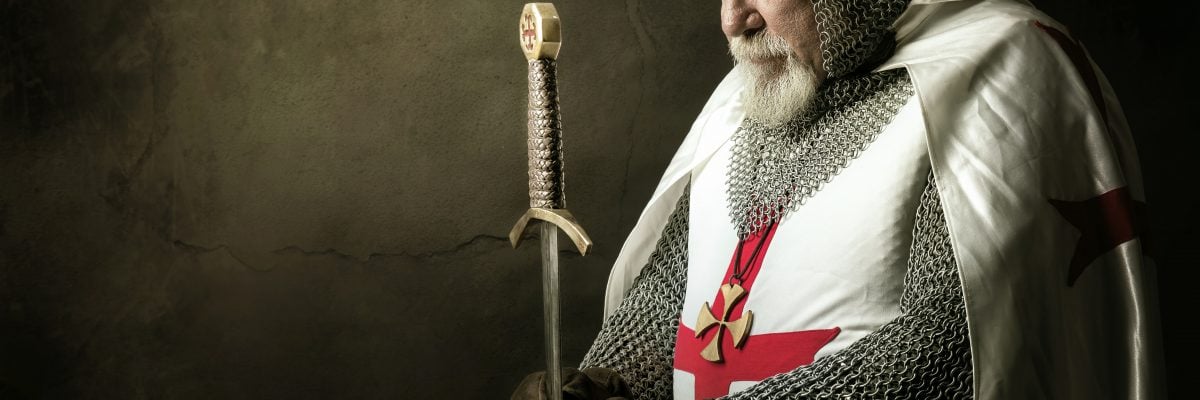
For many years, Hollywood’s treatment of the Crusades and the medieval period has been rooted in fallacy rather than historical fact (and not too popular at the box office), with Ridley Scott’s deplorable Kingdom of Heaven (2005) as a prime example. So, when I saw a trailer for the new History Channel series Knightfall, I was interested but wary of its accuracy. Unfortunately, my fears about an inaccurate portrayal of history (even allowing for appropriate dramatic license) were confirmed.
Knightfall purports to tell the history of the last days of the military religious order known as the Knights Templar. Although the show includes characters based on historical persons, such as Pope Boniface VIII (r. 1294–1303), King Philip IV of France (r. 1285–1314), Joan of Navarre (wife of Philip and queen of France), and William de Nogaret (the scheming aide to King Philip), the series is fictional and focuses much of its storyline on a quest to find the fabled Holy Grail— which the knights allegedly protected in the Holy Land but lost when they fled Acre, the last Christian city in Outrémer in 1291.
Since the show’s history leaves something to be desired, it will be useful for Catholics who want to view the show, or have family members, friends, and co-workers who watch it, to know the real story of these medieval knights.
The Knights Templar were one of the major military religious orders that grew out of the Crusading movement. After the First Crusade (1096–1102), there was a need to defend the territory liberated by the Christian armies. Since the majority of surviving Crusaders went home after the Battle of Ascalon in the summer of 1099, military necessity dictated a new form of soldier: the warrior-monk. Knights of the military religious orders were noblemen who vowed the evangelical counsels (poverty, chastity, and obedience) and dedicated their life to protecting Christian territory and pilgrims in the Holy Land. All those who participated in the Crusades performed the temporary military service as an act of devotion, but the warrior monks made crusading a permanent activity and way of life.
Founded in 1120 by Hugh of Payns and eight companions, including Andrew of Montbard, the uncle of St. Bernard of Clairvaux, the Knights were known originally as the Poor Knights of Christ. King Baldwin II of Jerusalem (r. 1118–1131) supported the order and provided part of the royal palace in the Jewish temple enclosure as their barracks, which gave birth to their new name: the Knights of the Temple or the Templars. After receiving papal approval in 1128, Hugh traveled throughout Europe requesting donations and recruiting men to serve in the Latin East. Monastically, the Templars embraced the Cistercian way of life, which was itself a strict and reformed following of the Rule of Saint Benedict. They wore a white habit with a simple red cross in the middle, and along with the evangelical counsels they took a special vow to protect Christian pilgrims on the road from the port city of Jaffa to Jerusalem.
The Templars were known for their ferocious fighting abilities and specific military rules, which included vowing to fight to the death for the holy places of Christendom, refusing to be ransomed if defeated in combat, and accepting every combat regardless of odds. The Templars were organized hierarchically with a master of the temple who was advised by a council of brothers. The order was divided into provinces overseen by commanders assisted by lieutenants and containing marshals, knights, sergeants, and squires. The order also included priests to provide for the spiritual needs of the members. Templar life was difficult and rooted in obedience. Templars were forbidden from kissing women, including relatives, and could not wear furs or hunt. Obedience was stressed in order to maintain discipline in the midst of the chaos of combat, and was exemplified by the rule that a knight could not even adjust his stirrup without first requesting and receiving permission from his superior.
Membership in the order grew as a result of the writing and preaching of Bernard of Clairvaux (1090–1153). Bernard wrote a treatise entitled On the Praise of the New Knighthood in which he exhorted knights to renounce the dangers of fighting for temporal reasons, which threaten the soul, in exchange for fighting for Christ and the Church, in which to die is to gain eternally:
Life indeed is fruitful and victory glorious, but according to holy law death is better than either of these things. For if those are blessed who die in the Lord, how much more blessed are those who die for the Lord?
As the order grew in membership it also increased in prominence and influence in the Holy Land and Europe; by 1150 the Templars could muster 600 knights, which, combined with the Hospitallers, amounted to half the total available knights in the Latin East. Their power in Christendom was rooted in the 9,000 feudal lordships and manors they owned, which provided a large base of resources and financial influence. Templar houses became known as important financial centers in Europe and served as places of deposit for Crusaders traveling to the Holy Land. They inaugurated the first primitive system of ATMs, allowing those who deposited funds in a Templar house in Europe to withdraw that amount minus a fee at Templar houses in the Latin East.
As the number of transactions increased, so did the Templar coffers from the surcharges. Their financial holdings and power became the envy of royalty and nobility throughout Europe, but especially in France. This situation incited the jealousy of King Philip IV “the Fair” of France and his advisor, William of Nogaret. On October 13, 1307, the king ordered the arrest of all Templars in France, which he had no authority to command since Templars were subject only to ecclesiastical courts. He conducted a royal investigation into charges, deviously concocted by de Nogaret, that the Templars performed anti-Christian rituals such as spitting on crucifixes and worshipping idols, and engaged in sodomy. Philip strongly urged Pope Clement V (r. 1305–1314) to suppress the order, which occurred at the ecumenical Council of Vienne in 1311.
Although Clement suppressed the order, he did not make a decision regarding Templar guilt or innocence. Templar land and property was officially given to another military religious order, the Hospitallers. Eventually, Philip IV ordered the execution of the master of the temple, Jacques de Molay, who was burned at the stake in Paris three years after the order’s suppression at Vienne.
The real story of the Templars is fascinating and worthy of an authentic portrayal in film, but History Channel’s Knightfall eschews the historical record and focuses instead on chasing the “holy grail” of ratings and commercial success by crafting a mythical telling of these brave warrior-monks of Christ.



